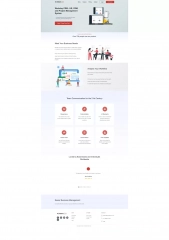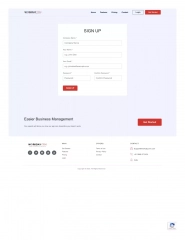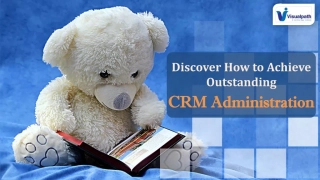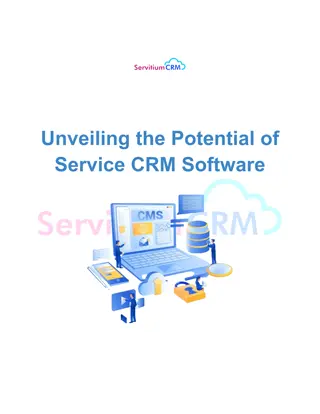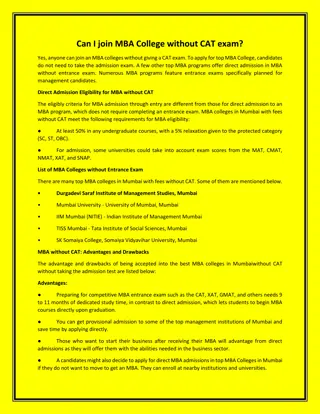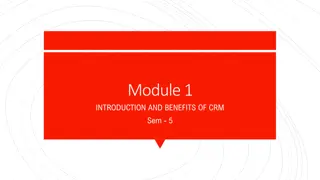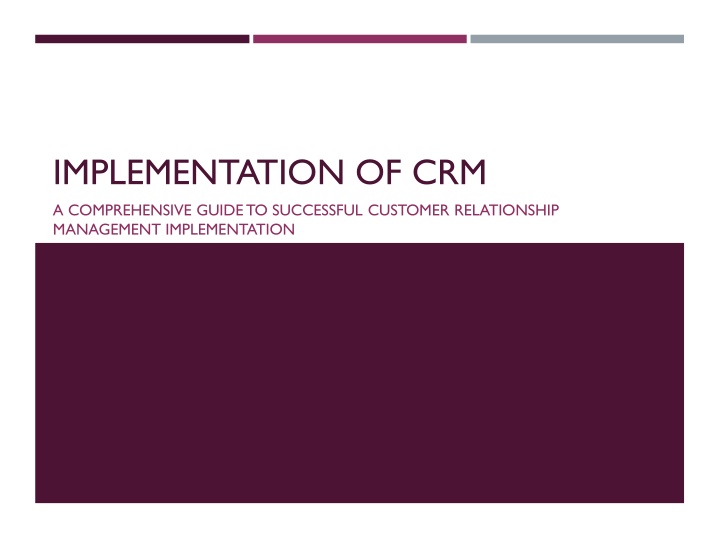
Comprehensive Guide to Successful CRM Implementation
Learn about the importance of Customer Relationship Management (CRM) implementation, steps involved, challenges faced, and best practices to ensure successful CRM implementation in your business. Enhance customer satisfaction, streamline operations, and drive sales growth with effective CRM strategies and software. Get insights on defining business objectives, choosing the right CRM solution, data migration, customization, employee training, system integration, and continuous monitoring. Overcome challenges such as resistance to change, poor data quality, lack of user training, integration issues, high implementation costs, and ineffective strategy. Discover best practices like gaining top management support and optimizing CRM processes to strengthen customer relationships and boost profitability.
Download Presentation

Please find below an Image/Link to download the presentation.
The content on the website is provided AS IS for your information and personal use only. It may not be sold, licensed, or shared on other websites without obtaining consent from the author. If you encounter any issues during the download, it is possible that the publisher has removed the file from their server.
You are allowed to download the files provided on this website for personal or commercial use, subject to the condition that they are used lawfully. All files are the property of their respective owners.
The content on the website is provided AS IS for your information and personal use only. It may not be sold, licensed, or shared on other websites without obtaining consent from the author.
E N D
Presentation Transcript
IMPLEMENTATION OF CRM A COMPREHENSIVE GUIDE TO SUCCESSFUL CUSTOMER RELATIONSHIP MANAGEMENT IMPLEMENTATION
INTRODUCTION TO CRM Customer Relationship Management (CRM) refers to the strategies, technologies, and practices that businesses use to manage and analyze customer interactions. The goal of CRM is to improve customer relationships, enhance customer satisfaction, increase retention, and drive sales growth. CRM software helps in streamlining processes, providing insights through data analytics, and ensuring seamless communication with customers.
IMPORTANCE OF CRM IMPLEMENTATION - Enhances customer satisfaction by providing personalized interactions. - Improves communication and collaboration within teams. - Streamlines business operations and automates tasks. - Provides valuable data insights for better decision-making. - Increases efficiency, productivity, and overall profitability. - Strengthens customer loyalty and retention by tracking customer history.
STEPS IN CRM IMPLEMENTATION (PART 1) 1. Define Business Objectives Identify key goals for CRM, such as improving sales, enhancing customer service, or increasing retention rates. 2. Choose the Right CRM Solution Select a CRM system that aligns with business needs, budget, and scalability requirements. 3. Plan Data Migration Ensure seamless transfer of customer data from existing databases to the new CRM system while maintaining data integrity.
STEPS IN CRM IMPLEMENTATION (PART 2) 4. Customize CRM for Business Needs Configure CRM workflows, fields, and automation features to match the organization's processes. 5. Train Employees Conduct training sessions to ensure that employees can effectively use the CRM system and adopt best practices. 6. Integrate with Existing Systems Connect the CRM with other business tools like ERP, email, marketing automation, and customer support software. 7. Monitor and Improve Continuously Regularly evaluate CRM performance, collect user feedback, and make necessary improvements to enhance effectiveness.
CHALLENGES IN CRM IMPLEMENTATION Resistance to Change Employees may be reluctant to adapt to new CRM systems. Poor Data Quality Inaccurate or incomplete data can hinder CRM effectiveness. Lack of User Training Without proper training, employees may underutilize CRM features. Integration Issues Compatibility problems with existing business tools can arise. High Implementation Costs Budget constraints can limit CRM adoption. Ineffective Strategy Poor planning can lead to underperformance and failure.
BEST PRACTICES FOR CRM IMPLEMENTATION Gain Top Management Support Leadership endorsement is crucial for successful implementation. Define Clear Goals and KPIs Set measurable objectives to track CRM success. Select a Scalable CRM Solution Choose software that can grow with the business. Ensure Proper Training Invest in training programs to enhance user adoption. Maintain Data Accuracy Regularly update and clean CRM data for reliability. Encourage Employee Engagement Involve employees in decision-making and feedback collection. Continuously Improve Monitor system performance and make necessary enhancements.
CONCLUSION Implementing CRM successfully requires careful planning, the right technology, and an adaptable strategy. By following structured steps and best practices, organizations can enhance streamline processes, and achieve long-term business growth. customer relationships, Continuous monitoring and improvement are key to maximizing CRM benefits.
PRECAUTIONS RELATED TO CRM IMPLEMENTATION 1. Define Clear Objectives Ensure the CRM implementation aligns with business goals. Identify specific needs such as improving customer retention, automating workflows, or increasing sales efficiency. 2. Choose the Right CRM Solution Select a CRM that fits your business size, industry, and long-term needs. Ensure scalability and customization options to adapt as the business grows. 3. Ensure Data Accuracy and Security Clean and validate data before migration to avoid duplicate or outdated records. Implement robust security measures to protect sensitive customer information.
PRECAUTIONS RELATED TO CRM IMPLEMENTATION 4. Gain Employee Buy-in and Provide Training Address resistance to change by involving employees early in the process. Offer hands-on training sessions to ensure smooth adoption and effective use. 5. Ensure Proper Integration Check compatibility with existing tools like ERP, email systems, and marketing automation software. Avoid siloed data by ensuring seamless integration across departments. 6. Establish Clear User Roles and Access Controls Define user roles and permissions to prevent unauthorized access. Assign responsibilities for CRM management and data updates.
PRECAUTIONS RELATED TO CRM IMPLEMENTATION 7. Plan for Ongoing Maintenance and Support Regularly update the CRM software to access new features and security patches. Provide continuous support to address technical issues and user concerns. 8. Monitor and Measure Performance Set Key Performance Indicators (KPIs) to track CRM success. Use feedback and analytics to refine CRM usage and improve customer experience. 9. Avoid Overloading with Features Focus on essential functionalities that match business needs. Avoid unnecessary add-ons that may complicate user adoption. 10. Ensure Compliance with Regulations Adhere to data protection laws like GDPR, CCPA, or industry-specific guidelines. Implement clear policies for customer data handling and consent management.


